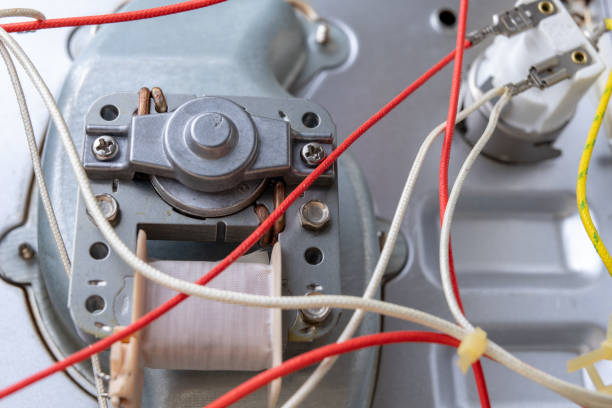Your home appliances need a lot more care and maintenance. It is not the same cleaning maintenance we are talking about, but the constant check and keeping track of everything in them. Among other things, you need to understand how to measure thermistor resistance. It can feel a little scary at first, but at the same time, it is a valuable skill because this can help you identify and repair all kinds of temperature-related issues. In the longer run, it will help you understand your appliance, take care of it and also save you money. Our guide will break down the whole thermistor resistance measurement process into easily manageable steps for you. By the end of this guide, you will also get to know the science behind these temperature-sensing parts!
What are Thermistors?
They are temperature-sensitive resistors that are quite important and necessary in today’s modern home appliances. Compared to traditional resistance temperature detectors, these thermistors are affordable and have quick response times to temperature changes. You will find them in almost every home appliance like refrigerators, ovens, dishwashers and even coffee makers, where they help maintain exact temperature control.
These parts are quite small and work on a simple principle – when the temperature changes, their electrical changes too. Almost all household appliances use Negative Temperature Coefficient thermistors, which means that their resistance decreases as the temperature increases. This relationship between temperature and resistance helps appliances to monitor and adjust their temperature properly.
Essential Tools for Measuring Thermistor Resistance
Get these tools before you start with the measurement process:
- A digital multimeter with resistance measurement capacity
- A thermometer for temperature readings
- Basic hand tools for accessing the thermistor
- Safety gloves
- Appliance’s service manual (if available)
These tools will be your basic testing kit. If you call a professional, they might use more specialised equipment. But, for a DIY check, this kit will be enough for basic diagnostic needs. The most important tool is the digital multimeter. Make sure to choose one with decent accuracy and a clear display so that the readings are easy to read.
Safety First!
You need to be extra careful with electrical appliances. Always unplug them before testing. Wait for the heated parts to cool down totally. With this, make sure you have good lighting and a clean workspace. Keep a record sheet with you so that you can easily note down the measurements. This will help you later when you are comparing readings and tracking your appliance’s changes.
Related: Understanding Wi-Fi Error Codes in Smart Home Appliances
Thermistor Resistance Measurement Process
Step 1: Locating the Thermistor
Its location can be different according to the appliance. In refrigerators. You will find it near the evaporator or in the fresh food compartment. Ovens usually have thermistor resistance in their cavity wall, while dishwashers mostly have them in the tub or near the heating element. Check your appliance’s manual for the exact location.
Step 2: Taking Initial Readings
Start by measuring the temperature in the area you want to. This will be your baseline. Most of the thermistors are rated for specific resistance values at room temperatures (usually 25 degrees Celsius). Your appliance’s documentation would have listed these specifications.
Step 3: Measuring Resistance
With the help of your multimeter set the thermistor resistance (ohms) function:
- Connect the probes to the thermistor terminals
- Record the reading
- Note the ambient temperature
- Compare your readings with the manufacturer’s specifications
Understanding Your Measurements
To read your resistance readings correctly, you need to first know about temperature and resistance in NTC thermistors. At room temperature and depending on its specifications, it will show anywhere from 5,000 to 50,000 ohms. If the readings are lower than what you’re expecting, then it means that your thermistor is failing. If it shows infinity readings, it often means the part has already failed completely.
Common Problems
When you are measuring the thermistor resistance, a lot of things can affect your readings:
Temperature Fluctuations
Even the smallest of temperature changes can affect the resistance readings. Make sure to take multiple measurements to make sure there is consistency.
Contact Issues
Sometimes a poor probe contact can give you incorrect readings. So, to prevent this make sure your multimeter probes are having good contact with the thermistor terminals. If there is any debris on the connections, clean them.
Circuit Interference
For exact readings, measure the thermistor alone whenever it is possible. Other circuit parts can also sometimes influence resistance measurements if the thermistor stays connected to the appliance’s circuit board.
Related: How to Safely Use a Household Trash Compactor
Practical Tips
When you are testing, sometimes it reveals patterns that can help you diagnose common issues. For example, a refrigerator that won’t cool might just show normal resistance readings but fail eventually under actual operating conditions. In cases like these, comparing readings at different temperatures can be a good way.
When you are having issues like these, you should note these down:
- Date and time of measurements
- Your Surrounding Temperature
- Resistance readings
- Any unusual things you noticed
- Operating conditions of your appliance
When to Call a Professional?
Usually measuring thermistor resistance is very straightforward, but some situations need professional attention. If you come across them, call up your technician:
- Your appliance shows multiple symptoms beyond temperature issues
- You can’t access the thermistor without major dismantling.
- The repair includes sealed systems or complicated electronics.
Maintenance Tips
The answer to the question of how to prevent appliance failure is simple – Regular thermistor testing. You should check the resistance readings during routine maintenance, especially for needed machines like refrigerators and freezers. Along with these, keep a log of the measurements you took to track the changes that might look like issues.
Related: How Diagnostic Modes Simplify Identifying Appliance Faults
Conclusion
Doing a thermistor resistance measurement is necessary, and understanding it fully is much more important. It will help you maintain and easily troubleshoot your appliances. The whole process does need attention to detail and basic technical knowledge. So, you will also develop these skills that will help you take care of other household appliances. Just remember – to have a good appliance diagnosis and repair, you need accurate measurements with proper documentation and safety procedures. Doesn’t matter if you are a DIY person or a trained technician, learning and mastering thermistor resistance measurement is a skill that you need in your maintenance toolkit. Above everything else, if you are not able to take the thermistor resistance reading yourself call Barton Appliance Repair! We’ll be there for you.





